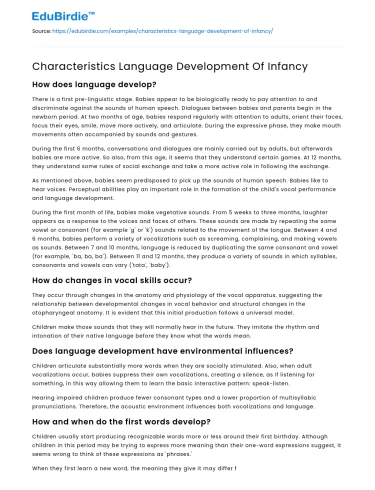How does language develop?
There is a first pre-linguistic stage. Babies appear to be biologically ready to pay attention to and discriminate against the sounds of human speech. Dialogues between babies and parents begin in the newborn period. At two months of age, babies respond regularly with attention to adults, orient their faces, focus their eyes, smile, move more actively, and articulate. During the expressive phase, they make mouth movements often accompanied by sounds and gestures.
During the first 6 months, conversations and dialogues are mainly carried out by adults, but afterwards babies are more active. So also, from this age, it seems that they understand certain games. At 12 months, they understand some rules of social exchange and take a more active role in following the exchange.
Save your time!
We can take care of your essay
- Proper editing and formatting
- Free revision, title page, and bibliography
- Flexible prices and money-back guarantee
As mentioned above, babies seem predisposed to pick up the sounds of human speech. Babies like to hear voices. Perceptual abilities play an important role in the formation of the child's vocal performance and language development.
During the first month of life, babies make vegetative sounds. From 5 weeks to three months, laughter appears as a response to the voices and faces of others. These sounds are made by repeating the same vowel or consonant (for example 'g' or 'k') sounds related to the movement of the tongue. Between 4 and 6 months, babies perform a variety of vocalizations such as screaming, complaining, and making vowels as sounds. Between 7 and 10 months, language is reduced by duplicating the same consonant and vowel (for example, 'ba, ba, ba'). Between 11 and 12 months, they produce a variety of sounds in which syllables, consonants and vowels can vary ('tata', 'baby').
How do changes in vocal skills occur?
They occur through changes in the anatomy and physiology of the vocal apparatus, suggesting the relationship between developmental changes in vocal behavior and structural changes in the otopharyngeal anatomy. It is evident that this initial production follows a universal model.
Children make those sounds that they will normally hear in the future. They imitate the rhythm and intonation of their native language before they know what the words mean.
Does language development have environmental influences?
Children articulate substantially more words when they are socially stimulated. Also, when adult vocalizations occur, babies suppress their own vocalizations, creating a silence, as if listening for something, in this way allowing them to learn the basic interactive pattern: speak-listen.
Hearing impaired children produce fewer consonant types and a lower proportion of multisyllabic pronunciations. Therefore, the acoustic environment influences both vocalizations and language.
How and when do the first words develop?
Children usually start producing recognizable words more or less around their first birthday. Although children in this period may be trying to express more meaning than their one-word expressions suggest, it seems wrong to think of these expressions as 'phrases.'
When they first learn a new word, the meaning they give it may differ from the usual meaning (for example, 'dog' used to refer to all animals, or to refer only to the family dog). There are individual differences both in the emission and in the moment of making the first words. In a study carried out, it was found that the most advanced children imitated a word at 9 months and the later ones at 18 months, just as in comprehension, in general, the understanding of words precedes their production.
To produce and understand words, an understanding of referents is necessary. Before the acquisition of language, this reference of objects occurs through gestural communication.
How is gestural communication carried out?
During the second half of the first year, babies begin to understand and use communicative signs, enhancing attention to external stimuli. Attention to external referents is the basis of symbolic communication, whether gestural or vocal. There is evidence that children who experience more with attention experiences tend to speak earlier and develop faster vocabulary.
Towards the end of the first year, children begin to share objects, using conventional gestures such as pointing, showing, etc., in order to direct the adult's attention to objects that arouse interest in the child. Towards the end of the second year, children frequently use conventional gestures (such as showing and offering objects) with parents.
Conventional gestures and language follow a parallel course of development. Children begin to use the shared, gestural or verbal referent, around the year-year and a half, when Piaget suggests the beginning of the capacity for symbolic representation.
How are pre-linguistic conversations conducted?
Interactive routines not only help children understand semantics, but also understand the pragmatism of language.
By 2 months, babies respond regularly to adult verbalizations, orienting their faces, focusing their eyes, smiling, becoming more active, and articulating. During the expressive phase, they perform mouth movements, often accompanied by gestures and sounds. The mothers respond with their own talk, towards 3 months, parents and baby alternate their vocalizations, the mothers being mainly responsible for the beginning of these exchanges.
During the first 6 months, conversations and dialogues are mainly held by adults. At 12 months they understand certain rules of social exchange and take a more active role.
The construction of the syntax is done while learning the succession of subject, action, object and recipient. Therefore, Bruner argues that before children actually speak, with adult guidance, they learn language formats.






 Stuck on your essay?
Stuck on your essay?

